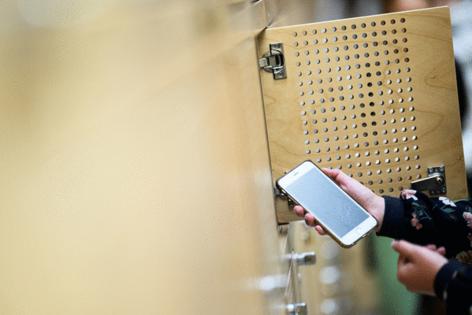Mary Ellen Klas: Want students to thrive? Lock up their phones
Published in Op Eds
There are few things most American politicians seem to agree upon, but banning mobile phones in classrooms seems to be one of them. Based on the experiences of some schools that have required students to prioritize learning over TikTok scrolling, there’s also a welcome side benefit: less conflict and more “hellos.”
When school starts this fall, students in most U.S. states and D.C. will be required by law to turn over or turn off their smartphones during all or most of the school day, according to an Education Week tally.
Florida, Louisiana, South Carolina and Utah have statewide bans. Another 24 states have adopted rules or laws that require restrictions on mobile phones but leave it up to school districts to decide whether to ban them or not. Two states offer districts incentives to restrict phones. Another seven recommend local districts enact their own restrictions.
The methods and policy details vary widely between states, but the reasons for silencing phones are pretty universal. A growing body of research has found that the more time children and their developing brains spend on smartphones, the greater the risk of negative mental health outcomes — from depression, to cyberbullying, to an inability to focus and learn.
Social media is intentionally designed “to expose users to an endless stream of content” which makes it addictive, said Carol Vidal, a child and adolescent psychiatrist at the Johns Hopkins Children’s Center. That’s especially risky for children and teens, she said, “because their brains are still developing, and they have less control over their impulses.”
The laws are spurred in part by the research discussed in the 2024 book by Jonathan Haidt The Anxious Generation. The New York University professor elevated this theory after reviewing dozens of recent studies linking social media and smartphone use by kids and teens to the explosive increase in rates of anxiety among young people, including emergency room visits for self-harm.
The idea of severing the phone from the classroom not only has legislators and governors in red and blue states giving it near-unanimous support, a 2024 survey by Pew Research found that 68% of US adults support a ban on smartphone use among middle- and high-school students during class.
But a ban in theory is not the same as putting it into practice, especially for the large numbers of parents worried about being unable to contact their kids during the school day.
That’s something Principal Inge Esping noticed when she barred phones from classrooms at McPherson Middle School in Kansas, an hour north of Wichita. In 2022, when Esping started as the school’s principal, she noticed that the spike in online bullying among students was happening during the school day.
“Middle schoolers are a little notorious for when they’re trying to make fun of someone,” she told me. “They’ll take a picture of the person that they’re making fun of and share that via social media — especially during lunchtime.’’
Absences and suspensions were rising, with too many students staying home either because they feared confronting their bullies or because they were bullying others. She and her staff decided to impose a rule in the 2022–23 school year requiring students to turn off their phones and store them in their lockers from the first bell to the last.
With few exceptions, children who had grown up with mobile phones “simply accepted it,” Esping said. It was their parents who protested.
“I don’t think we really realized how much parents were reaching out to their students during the school day,” Esping recalled. Many parents feared being unable to communicate with their children during school hours, particularly in an era of school shootings. Others didn’t trust the school to notify them when their child needed them, she said.
She and her colleagues then embarked on an ambitious plan to persuade parents of the value of keeping phones out of reach during school hours. She organized back-to-school events to increase communication, engaged more parents in volunteer and visiting opportunities, and refined the school’s alert system that notifies families when there’s an emergency.
As parents grew to accept the new system, the results for their children were dramatic. In the first year, the school saw a 5% increase in their state assessment scores in both reading and math. School suspensions dropped 70% by Christmas and have remained at half the rate they were before the ban. And absenteeism went down from 39% to 11% — because taking phones away prevented many of the harmful social media comments that kept bullied kids from coming to school.
Other school districts with mobile phone restrictions reported similar results in student discipline. A year after the Orange County School District in Florida implemented its phone ban in 2023, fighting went down 31% and “serious misconduct” issues decreased by 21%, Superintendent Maria Vazquez told Florida lawmakers in January.
Results like that are, in part, what have spurred elected officials to act.
“Arkansas’ phone-free schools’ program isn’t about taking anything away,” declared Republican Gov. Sarah Huckabee Sanders when she signed Arkansas’ mobile phone ban earlier this year. “It’s about giving kids the freedom to learn without distractions.”
The idea is getting some traction in Washington, too. One of the final acts of the Biden administration’s Department of Education was to issue a recommendation that all states and districts adopt measures to manage smartphone use in schools.
In February, Senators Tim Kaine, a Democrat from Virginia, and Tom Cotton, a Republican from Arkansas, introduced legislation to study the effects of mobile phone use in schools. Recently, Democratic Senator Elise Slotkin of Michigan called for a ban on “social media and cell phones in every K-12 classroom in America.” She blamed technology for interfering in “problem-solving skills that will be valuable in the future economy.”
But for teachers, the most tangible difference has been the “huge vibe change,” said Esping, who was named Kansas Middle School Principal of the Year in April. Teachers reported that students were now more engaged — in the classroom and school corridors.
“The year before the phone ban, you’d say ‘hello’ to a student and they would ignore you and move on because they’re so tied to their cell phone,” Esping told me. But after the ban, “kids were looking up and talking to one another,” especially in the lunchroom and as students transitioned between classes. “When you’d say, ‘good morning’ to them, they’d say ‘good morning’ back.”
As always, students may be teaching the rest of the nation something here. Maybe more smartphone bans are exactly what we need.
____
This column reflects the personal views of the author and does not necessarily reflect the opinion of the editorial board or Bloomberg LP and its owners.
Mary Ellen Klas is a politics and policy columnist for Bloomberg Opinion. A former capital bureau chief for the Miami Herald, she has covered politics and government for more than three decades.
©2025 Bloomberg L.P. Visit bloomberg.com/opinion. Distributed by Tribune Content Agency, LLC.

























































Comments